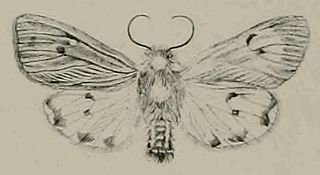
The Arctiinae are a large and diverse subfamily of moths, with around 11,000 species found all over the world, including 6,000 neotropical species. This group includes the groups commonly known as tiger moths, which usually have bright colours, footmen, which are usually much drabber, lichen moths, and wasp moths. Many species have "hairy" caterpillars that are popularly known as woolly bears or woolly worms. The scientific name of this subfamily refers to this hairiness. Some species within the Arctiinae have the word tussock in their common name due to people misidentifying them as members of the Lymantriinae based on the characteristics of the larvae.

Schinia, commonly called flower moths, is a large genus of moths belonging to the family Noctuidae. The genus has a Holarctic distribution with the vast majority of species being found in North America, many with a very restricted range and larval food plant.

Eutrochium purpureum, commonly known as purple Joe-Pye weed, kidney-root, sweetscented joe pye weed, sweet Joe-Pye weed, is an herbaceous perennial plant in the sunflower family. It is native to eastern and central North America, from Ontario east to New Hampshire and south as far as Florida, Louisiana, and Oklahoma. It is sometimes called gravel root,trumpet weed or feverweed.
The Maltese ruby tiger moth is a subspecies of moth endemic to the Maltese Islands. It was first described by Otto Bang-Haas in 1927. It belongs to the subfamily Arctiinae.

Epatolmis is a monotypic genus of tiger moths in the family Erebidae erected by Arthur Gardiner Butler in 1877. Its single species, Epatolmis caesarea, was first described by Michael Denis and Ignaz Schiffermüller in 1775. It is found in Europe, Asia Minor, southern Siberia, Amur, Mongolia, northern China up to Korea and Japan.

Phragmatobia fuliginosa, the ruby tiger, is a moth of the family Erebidae.

Phragmatobia is a genus of moths in the subfamily Arctiinae described by Stephens in 1828. Many tiger-moth species of small and medium size were described within this genus. However, only a few are related to the type species.

Catocala meskei, or Meske's underwing, is a moth of the family Erebidae. The species was first described by Augustus Radcliffe Grote in 1873. It is found in North America from Maine and Quebec west to southern Alberta and Montana, south to South Carolina in the east and at least Montana in the west.

Zosteropoda hirtipes, the V-lined Quaker moth is a moth of the family Noctuidae first described by Augustus Radcliffe Grote in 1874. It is found from the wet Pacific coast forests of North America east to the Rocky Mountains.

Lophocampa maculata, the spotted tussock moth, mottled tiger or spotted halisidota, is a moth of the family Erebidae and the tribe Arctiini, the tiger moths. The species was first described by Thaddeus William Harris in 1841. It is found across Canada, the western parts of the United States, south in the Appalachians to South Carolina and Kentucky.
Grammia virgo, the virgin tiger moth, is a moth of the family Erebidae. The species was first described by Carl Linnaeus in his 1758 10th edition of Systema Naturae. It is found in North America from Newfoundland south to Florida west to Alberta.

Grammia phyllira, the phyllira tiger moth, is a moth of the family Erebidae. It was described by Dru Drury in 1773. It is found in North America from Quebec and New England south to Florida and west to Texas, Colorado and Alberta. The habitat consists of dry, open woodland and grassland. The species is listed as endangered in Connecticut.
Pararctia yarrowii, or Yarrow's tiger moth, is a moth of the family Erebidae. It was described by Richard Harper Stretch in 1874. It is found in North America from Hudson Bay to British Columbia and northern Arizona. The habitat consists of barren rocky fellfields and slides above the timberline. These moths are also found in the Pacific Northwest.
Phragmatobia amurensis is a moth in the family Erebidae. It was described by Seitz in 1910. It is found in the Russian Far East, China, Korea and Japan.
Phragmatobia assimilans, the large ruby tiger moth, is a moth in the family Erebidae. It was described by Francis Walker in 1855. It is found in North America from Nova Scotia to Connecticut, in the east to British Columbia. There are isolated populations in northern Colorado and the Black Hills of South Dakota. The habitat consists of open meadows and moist forests.

Phragmatobia placida is a moth in the family Erebidae. It was described by Imre Frivaldszky in 1835. It is found in Albania, Bosnia and Herzegovina, Bulgaria, North Macedonia, Greece, Ukraine, Asia Minor and the Near East.
Crambus trichusalis is a moth in the family Crambidae. It was described by George Duryea Hulst in 1886. It is found in North America, where it has been recorded from Alberta, Saskatchewan, Montana, North Dakota and South Dakota. The habitat consists of grasslands.









